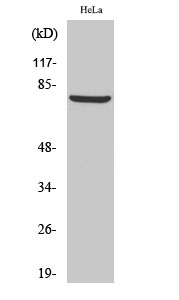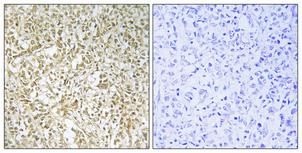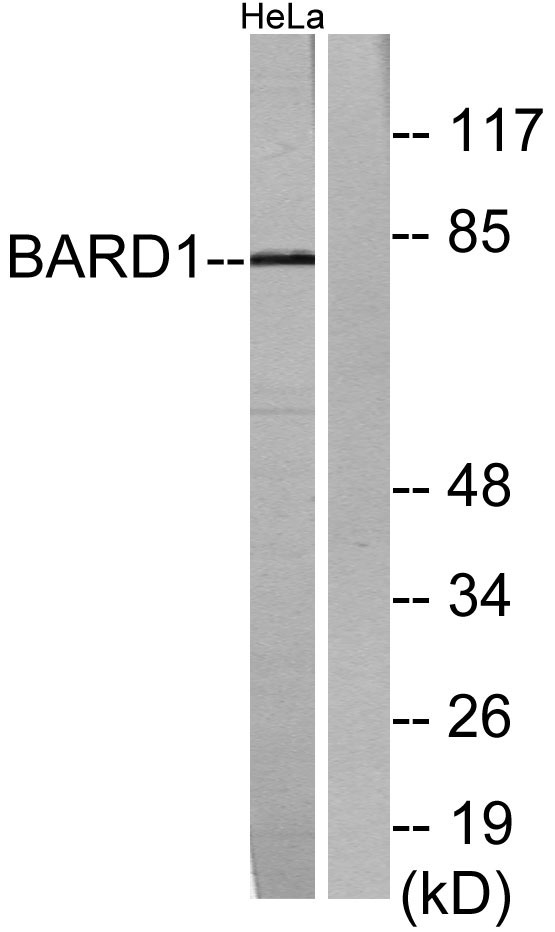BARD1 Polyclonal Antibody
- Catalog No.:YT0452
- Applications:WB;IHC;IF;ELISA
- Reactivity:Human;Rat;Mouse;
- Target:
- BARD1
- Fields:
- >>Homologous recombination
- Gene Name:
- BARD1
- Protein Name:
- BRCA1-associated RING domain protein 1
- Human Gene Id:
- 580
- Human Swiss Prot No:
- Q99728
- Mouse Swiss Prot No:
- O70445
- Immunogen:
- The antiserum was produced against synthesized peptide derived from human BARD1. AA range:1-50
- Specificity:
- BARD1 Polyclonal Antibody detects endogenous levels of BARD1 protein.
- Formulation:
- Liquid in PBS containing 50% glycerol, 0.5% BSA and 0.02% sodium azide.
- Source:
- Polyclonal, Rabbit,IgG
- Dilution:
- WB 1:500 - 1:2000. IHC 1:100 - 1:300. ELISA: 1:5000.. IF 1:50-200
- Purification:
- The antibody was affinity-purified from rabbit antiserum by affinity-chromatography using epitope-specific immunogen.
- Concentration:
- 1 mg/ml
- Storage Stability:
- -15°C to -25°C/1 year(Do not lower than -25°C)
- Other Name:
- BARD1;BRCA1-associated RING domain protein 1;BARD-1
- Observed Band(KD):
- 79kD
- Background:
- This gene encodes a protein which interacts with the N-terminal region of BRCA1. In addition to its ability to bind BRCA1 in vivo and in vitro, it shares homology with the 2 most conserved regions of BRCA1: the N-terminal RING motif and the C-terminal BRCT domain. The RING motif is a cysteine-rich sequence found in a variety of proteins that regulate cell growth, including the products of tumor suppressor genes and dominant protooncogenes. This protein also contains 3 tandem ankyrin repeats. The BARD1/BRCA1 interaction is disrupted by tumorigenic amino acid substitutions in BRCA1, implying that the formation of a stable complex between these proteins may be an essential aspect of BRCA1 tumor suppression. This protein may be the target of oncogenic mutations in breast or ovarian cancer. Multiple alternatively spliced transcript variants encoding different isoforms have been found for this gen
- Function:
- caution:It is uncertain whether Met-1 or Met-26 is the initiator.,disease:Defects in BARD1 gene are found in primary breast, ovarian and uterine cancers.,function:The BRCA1-BARD1 heterodimer coordinates a diverse range of cellular pathways such as DNA damage repair, ubiquitination and transcriptional regulation to maintain genomic stability. Plays a central role in the control of the cell cycle in response to DNA damage. Acts by mediating ubiquitin E3 ligase activity that is required for its tumor suppressor function. Also forms a heterodimer with CSTF1/CSTF-50 to modulate mRNA processing and RNAP II stability by inhibiting pre-mRNA 3' cleavage.,pathway:Protein modification; protein ubiquitination.,PTM:Processed during apoptosis. The homodimer is more susceptible to proteolytic cleavage than the BARD1/BRCA1 heterodimer.,similarity:Contains 1 RING-type zinc finger.,similarity:Contains 2 B
- Subcellular Location:
- Nucleus. During S phase of the cell cycle, colocalizes with BRCA1 into discrete subnuclear foci. Can translocate to the cytoplasm. Localizes at sites of DNA damage at double-strand breaks (DSBs); recruitment to DNA damage sites is mediated by the BRCA1-A complex.
- Expression:
- B-cell,Brain,
- June 19-2018
- WESTERN IMMUNOBLOTTING PROTOCOL
- June 19-2018
- IMMUNOHISTOCHEMISTRY-PARAFFIN PROTOCOL
- June 19-2018
- IMMUNOFLUORESCENCE PROTOCOL
- September 08-2020
- FLOW-CYTOMEYRT-PROTOCOL
- May 20-2022
- Cell-Based ELISA│解您多样本WB检测之困扰
- July 13-2018
- CELL-BASED-ELISA-PROTOCOL-FOR-ACETYL-PROTEIN
- July 13-2018
- CELL-BASED-ELISA-PROTOCOL-FOR-PHOSPHO-PROTEIN
- July 13-2018
- Antibody-FAQs
- Products Images

- Western Blot analysis of various cells using BARD1 Polyclonal Antibody

- Immunohistochemical analysis of paraffin-embedded Human breast cancer. Antibody was diluted at 1:100(4° overnight). High-pressure and temperature Tris-EDTA,pH8.0 was used for antigen retrieval. Negetive contrl (right) obtaned from antibody was pre-absorbed by immunogen peptide.

- Western blot analysis of lysates from HeLa cells, using BARD1 Antibody. The lane on the right is blocked with the synthesized peptide.



